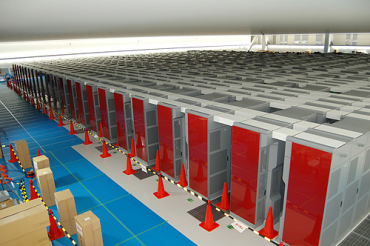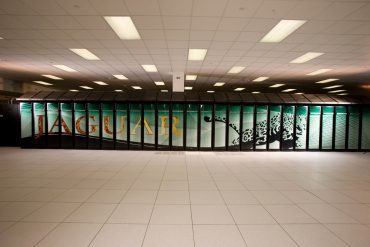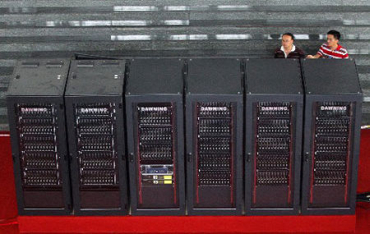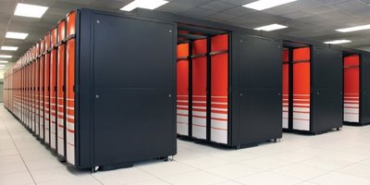 | « Back to article | Print this article |
World's top 10 supercomputers!
Supercomputers are used for highly calculation-intensive tasks such as problems involving quantum physics, weather forecasting, climate research, molecular modeling (computing the structures and properties of chemical compounds, biological macromolecules, polymers, and crystals), physical simulations (such as simulation of airplanes in wind tunnels, simulation of the detonation of nuclear weapons, and research into nuclear fusion).
On Wednesday, a Fujitsu supercomputer became the fastest computing machine in the world, overtaking Chinese one.
Let us have a look at world's top 10 supercomputers.
Click NEXT to read more...
World's top 10 supercomputers!
The machine, jointly developed by Fujitsu Ltd. and the government-affiliated Riken research institute, has claimed the supercomputing crown.
The K computer is far faster than rivals, boasting more than three times the number-crunching power of the previous holder of the title. The name of the machine comes from the Japanese word "Kei", which means 10 peta, or 10 quadrillion (10,000 trillion), reflecting the project's goal of creating a supercomputer that can make 10 quadrillion calculations (floating-point operations) per second, or, in computer science jargon, 10 petaflops.
The K computer, which is slated to be completed next summer, sped to the front of the class by reaching more than 8 quadrillion calculations per second, even though it can currently only operate at 80 to 90 per cent of its expected capacity.
Click NEXT to read more...
World's top 10 supercomputers!
The supercomputer is capable of an Rmax (maximum range) of 2.566 petaflops; that is, over two-and-a-half quadrillion (thousand million million) floating point operations per second.
Located at the National Supercomputing Centre in Tianjin, China, it was the fastest computer in the world from October 2010 to June 2011 and is one of the few Petascale supercomputers in the world.
Click NEXT to read more...
World's top 10 supercomputers!
This machine is a petascale supercomputer built by Cray at Oak Ridge National Laboratory in Oak Ridge, Tennessee.
The massively parallel Jaguar has a peak performance of just over 1,750 teraflops (1.75 petaflops). It has 224,256 x86-based AMD Opteron processor cores, and operates with a version of Linux called the Cray Linux Environment. Jaguar is a Cray XT5 system, a development from the Cray XT4 supercomputer.
Click NEXT to read more...
World's top 10 supercomputers!
It is a petascale supercomputer located at the National Supercomputing Centre in Guangdong, China.
Built from a Dawning TC3600 Blade system with Intel Xeon X5650 processors and Nvidia Tesla C2050 GPUs, it has a peak performance of 1.271 petaflops using the Linpack benchmark suite.
Nebulae was ranked the second-most powerful computer in the world in June.
It has a theoretical peak performance of 2.9843 petaflops.
Click NEXT to read more...
World's top 10 supercomputers!
It boasts 2,816 six-core, 2.96GHz Xeon 5600 processors, along with 4,224 units of Nvidia's Tesla M2050 general-purpose GPUs to hit 2.39 petaflops, creating the first petaflop supercomputer in Japan.
The actual construction of the system has been done by NEC Corp and HP.
Click NEXT to read more...
World's top 10 supercomputers!
The Cielo supercomputer at Los Alamos National Laboratory in New Mexico performs at 1.11 petaflops.
With a projected cost of $54 million, Cielo is the next generation capability class platform for the Advanced Simulation and Computing programme.
The total hardware takes up about 1,500 feet and uses four megawatts of memory.
Click NEXT to read more...
World's top 10 supercomputers!
It is a petascale supercomputer built by SGI at Nasa Ames Research Centre in Mountain View, California.
As of June 2010, it was the world's sixth fastest computer with a peak performance of more than 970 teraflops.
After further extensions, Pleiades is scheduled to reach 10 petaflops in 2012.
Click NEXT to read more...
World's top 10 supercomputers!
A 153,408 processor-core Cray XE6 system managed 1.05 petaflops (quadrillions of calculations per second) running the Linpack benchmark.
The system was installed in September 2010.
Click NEXT to read more...
World's top 10 supercomputers!
The result of a collaborative programme that began in 2008, Tera 100 is the first petaflops-scale supercomputer ever designed and developed in Europe.
Its theoretical maximum power of 1.25 Petaflops means it ranks among the most powerful supercomputers in the world.
Tera 100 has been built for the French nuclear weapons simulation programme, aimed at guaranteeing the reliability of nuclear deterrent weapons.
Click NEXT to read more...
World's top 10 supercomputers!
Roadrunner
It is a supercomputer built by IBM at the Los Alamos National Laboratory in New Mexico, US.
The $133-million Roadrunner is designed for a peak performance of 1.7 petaflops, achieving 1.026 on May 25, 2008 to become the world's first TOP500 Linpack sustained 1.0 petaflops system.
It is a one-of-a-kind supercomputer, built from off the shelf parts, with many novel design features.
In November 2008, it reached a top performance of 1.456 petaflops, retaining its top spot in the TOP500 list.










